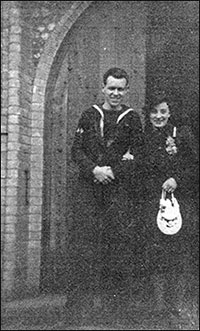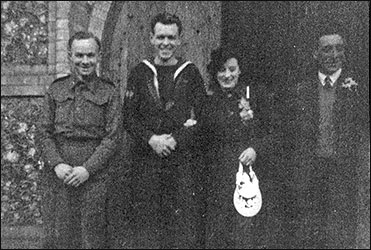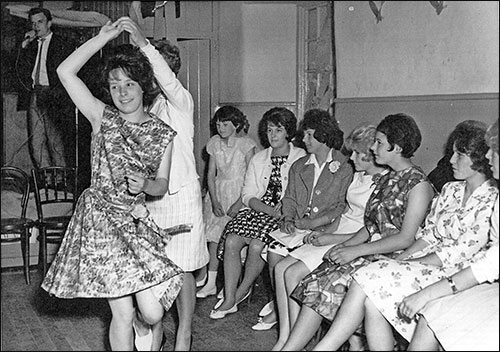|
Jack was born on 24th January 1924 at 89 Trafford Road, Rushden. His Mother had a difficult time giving birth and consequently he was badly bruised. The Doctor attending the birth thought Jack had little chance of survival. He instructed the lady caring for Jack's Mother to leave Jack at the bottom of the bed unclothed and was certain Jack would die within a short time. However his Mother woke during the night, found him, wrapped him in a blanket and cuddled him in bed with her. He survived with no ill effects, much to the Doctor’s surprise; he would shake his head in amazement whenever he saw Jack in the following years.
The years passed, Jack went to school at Newton Road Infants when he was five. When the family moved to Harborough Road to run a shop, Jack went to Southend School. They later moved to Park Road when the shop became too much for his Mother to cope with and Jack continued to attend Southend School. At that time Southend school was the stone building in High St South. It was the law then for children to leave school at fourteen. When he left school at the Easter term in 1938 he had to work at the Co-op shoe factory. That was a huge building situated on the corner of Rectory Road and Portland Road, converted to flats in 1994.
The following year war was declared, life went on uneventfully until 1940 when Jack was seriously ill with pneumonia and was not expected to recover. However, once again he rallied, thanks mostly to a new drug discovered about that MB693.
Two years later like many more young men at eighteen, he was anxious to join one of the armed forces. He chose the Navy and along with Jack Smith volunteered. They had to report to Dover and St James Hall at Northampton 24th August 1942. They had to be there by 12.30 for a medical to decide if they were physically for the Navy. They travelled by train from Rushden, changing trains at Wellingborough. At that time trains ran from Rushden to Wellingborough several times daily. After passing the fitness examination they were called up for service on the 15th November 1942. First they had to report to Skegness, again travelling by rail. The naval base at Skegness was called HMS Royal Arthur. They were billeted in Butlins holiday camp chalets. The holiday camp had been taken over by the government for the duration of the war. The chalets had been built for summer holidays in 1936 and were very basic. Ice formed on the windows as there was no heating. Only there for sixteen days. During that time they were issued with uniforms, kit bags and a hammock. Also they had to have several injections to immunise against infections; Tetanus, TB and various others. Jack Smith was one of the many that fainted while receiving their injections.
On 25th November 1942 they were moved to Ayr in Scotland. They travelled by train once more and passed through Northampton which caused some sadness as they were unable to go home. Along with most other young men called up for war service, the suffered from occasional bouts of home sickness. They had never been away from home and family. Now they had to go where they were told and obey orders at all times.
The naval base at Ayr was called HMS Scotia. This was another Butlins peace time holiday camp taken over by the government. The chalets were a big improvement on the ones at Skegness. They had heating and were more solidly built. They went to Ayr for a course to learn to be ordinary signalmen. Jack passed his exams on the 8th April, Jack Smith failed, it meant the passing of the ways for those two. Jack was moved to Cookham camp HMS Pembroke at Chatham on 15th April 1943, while Jack Smith had to stay at Ayr to do the signalman's course again. The billet at Chatham was in a nissen hut, Jack had to signal school for more tuition. He was there until 22nd May 1943. When he was drafted to the destroyer Hotspur in Chatham dockyard. Reg Dickens another Rushden man, a few years older than Jack, was also drafted to the Hotspur at the same time he was a seaman gunner. That was a pleasant surprise for both of them. They only met up occasionally on board.
The destroyer sailed the same day for Tobermory in Scotland. The naval base there was known as HMS Kenny. Jack went for 9 days to practice his signalling. As part of the course along with a few ratings they had to board submarines. One dived while they were on it but they managed to get off in time. The Hotspur then sailed for Londonderry (HMS Fenet) on 31st May 1943. The following day 1st June 1943 they began escorting convoys to St Johns Newfoundland. The escort vessels were the Hotspur, two more destroyers, one was an old Canadian, one American called Churchill, one trawler and three corvettes. Seven ships altogether to watch over the convoy which usually was made up of thirty vessels. On arrival at St Johns the convoy was taken over by another escort while the Hotspur and co. escorted another convoy back to Londonderry. From 1st June 1943 to mid February Jack went from Londonderry to St Johns and back seven times. The time taken for each trip varied as they had to keep to the speed of the slowest vessel. Jack had to stand on the Bridge of the Hotspur when he was on watch four hours on, four off, a very traumatic time for him. There were the Atlantic gales to contend with and very rough seas. The Atlantic rollers taking the ship up and dropping it down. He had to read the signals from the lamps in Morse code, there had to be no mistakes, all the time watching out for U-boats.
There were four hour watches unless it was action stations. When he was off watch he spent his spare time scrubbing the mess deck, doing his laundry and cooking for the crew he shared quarters with.
There were 15 of them so no room to spare. They slept in hammocks and washed themselves and their clothes in the galley using water from a bucket. They had three days leave occasionally, by the time Jack finally arrived home on leave from Londonderry it was almost time for him to go back. He spent what money he had on tinned fruit and sweets to bring home. These things were a real luxury for the family.
The Hotspur left St Johns arriving in Liverpool 31st March 1944. While there he passed an exam for signalman. This meant an increase in pay. Three weeks later 21st April they sailed for Plymouth. They had a lot of exercises along the coast, and then mid May the Hotspur patrolled the French coast to draw fire from the German shore artillery. This was to find out where the guns were prior to D-Day 6th June. The invasion of Normandy took place in the morning, by afternoon the Hotspur along with the other four ships were giving support to the invading forces. During one encounter with the enemy a mine exploded almost under the Hotspur, as the Hotspur was going quite fast it exploded after the Hotspur had passed. The only damage the power generator was knocked off. Jack was up a ladder between decks when the blast knocked him off. However he was lucky to escape injury. Some days after D-day the five destroyers and Frigates found a U-boat in the channel and crippled it near the shore. German coastal batteries opened up but two of the Frigates went in for the kill while the other ringed round making a smoke screen. Next day still under the enemies nose the vessels picked up 140 survivors from a German vessel which had been sunk during a night of action near the French cliffs. The Germans were surprised when they found themselves rescued by their enemy. Later the destroyers and Frigates went right inshore to pick up more survivors. This time from the German aircraft taking part in a fierce air battle. Planes were falling from the sky all around the ships.
February 1944 the Hotspur went to Lofoten high up in Norway. Probably as back up to the midget submarine all top secret.
Back to Chatham barracks in September 1944, sorting mail for 12 hours every night until December 1944.
Home on 48 hour leave 23rd December 1944 back to Falmouth 24th December, his Father died suddenly 25th December 1944 so back to Kettering for a week as compassionate leave. Got married on 31th December.
Top secret trip taking Winston Churchill cancelled then back to Chatham barracks 18th January 1944. From then until 6th February 1945 the family thought he had sailed for the Far East. However he came home unexpectedly 6th February for ten days leave.
17th February 1945 he joined the Stirling Castle Liner at Liverpool taken over as a troop ship and arrived in Sydney 31st March 1945 via the Panama Canal. Went to Wellington New Zealand then to Brisbane dropping off troops before arriving at Sydney race course. Worked at the docks in Sydney, the Dockers were on strike, had dysentery went in sick bay, was bitten by sand flies in the bed. Then to Melbourne for America signals course.
25th October 1945 boarded the Undaunted from Sydney, to Japan. Stopped at Guan to drop sailors off with appendicitis. Sailed round islands went to Tokyo, niko Yokohama. News of Ann's birth three weeks after she was born by telegram from England from Aunt Elsie.
1st January 1946 escorted the Indefatigable back to England. Pushed air craft off into sea. Stopped at Cape Town went up Table Mountain with Butch Burrows.
Arrived in Chatham 19th March, released 7th June 1946.
Joined Royal Naval Reserves 23rd November 1948, discharged 20th April to join the police force.
Arrived in Chatham November 1952, 15th January Widemouth Bay member of ships convoy. Boys training ship, Rosyth, Norway, Holland, Kiel canal, Lerwick until 9th October. Steepholm 15th February east coast blowing up wrecks off the coast at Southwold, upset the locals with the noise. Postman stranded at Southwold, too rough for the boat to pick him up. 16th February 1954 till 11th March 54 on Barkis bar boat, until demob.
|



